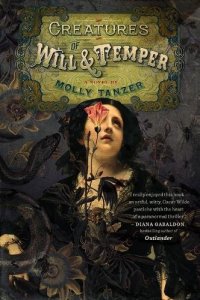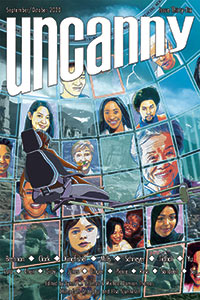Paul Di Filippo reviews Creatures of Will and Temper by Molly Tanzer
Creatures of Will and Temper, Molly Tanzer (Houghton Mifflin Harcourt/John Joseph Adams 978-1-328-71026-0, $16.99, 368pp, trade paperback) November 2017
 The earliest publication from relative newcomer Molly Tanzer–as certified both by ISFDB and her own website–seems to be 2010’s “In Sheep’s Clothing,” from Running with the Pack, an anthology edited by Ekaterina Sedia. Although 2010 seems, from one vantage, to be the day before yesterday, it’s seven years gone now, and Tanzer has not been idle in those years, producing two short-story collections and three novels. This month brings her fourth novel, the first to be shepherded into print by a large publisher, courtesy of the editorial acumen of John Joseph Adams, whose imprint is racking up some stellar choices.
The earliest publication from relative newcomer Molly Tanzer–as certified both by ISFDB and her own website–seems to be 2010’s “In Sheep’s Clothing,” from Running with the Pack, an anthology edited by Ekaterina Sedia. Although 2010 seems, from one vantage, to be the day before yesterday, it’s seven years gone now, and Tanzer has not been idle in those years, producing two short-story collections and three novels. This month brings her fourth novel, the first to be shepherded into print by a large publisher, courtesy of the editorial acumen of John Joseph Adams, whose imprint is racking up some stellar choices.
Tanzer’s Big Five debut is hardcore steampunk of the hybrid scientific-occult variety, in a league with classic work by Powers, Blaylock and Jeter. It’s a little slow to achieve escape velocity, but when it does, the takeoff is sufficiently awe-inspiring.
We should start with Tanzer’s preface that explains the book is an homage with variations on Wilde’s The Picture of Dorian Gray. Thus informed, we are not surprised to encounter a prologue in which an artist is obsessively painting a portrait. The painter is one Basil Hallward. The subject of his art is his dead lover, Oliver Wotton, whose unusual demise is only hinted at. In the studio with Hallward is Lady Henrietta “Henry” Wotton, sister to the dead man. She makes cryptic references to an organization that all of three of them belonged to, and from which Hallward has recently resigned. Also, Henry appears to be carrying an unnatural subpersonality in her head. With these uncanny matters looming, we learn that Hallward’s two nieces are about to pay an extended visit to London and stay with him.
One of the nieces, the younger, beautiful and more wayward girl, is named Dorina Gray. Her older sister, Evadne, is something of a reluctant tomboy, never glamorous, but commonsensical and adept with a fencing rapier. We witness their homelife and get a chance to gauge their sisterly relations. Then we are off to London.
In the city, Dorina falls under the mentorship of Henry. The fact that both of the women, the older and younger, are lesbians is not unconducive to their blossoming friendship. Evadne, meanwhile, seeks to extend her skills by enrolling in a fencing school. There she embraces the tutelage of one George Cantrell, “Saint George,” a man with a mission.
Now, what I have just crudely synopsized is the entire first half of the novel. Oh, yes, there are many instances of witty banter, finely wrought naturalistic descriptions, and Trollope-worthy social set pieces, as well as the introduction of a dozen other nicely minted secondary characters. But aside from the barest occasional gleams of the supernatural, there is really nothing up to this point to qualify the book as steampunk, or satisfy those initials hints. This is where I would, as hypothetical editor, have suggested a paring-down of the buildup. When you contrast the action-packed pages of the first half of, oh, The Anubis Gates with this book (they are of a similar length), I think you’ll see what I mean.
But Tanzer’s slower, more meditative path is not unenjoyable, despite a little readerly chafing for the show to get underway. And sure enough, she takes flight heartily by the midpoint. Dorina attends a kind of Hellfire Club meeting at Henry’s manse, where she begins to learn about a race of demons that take their pleasures while working through humans. And Evadne is enlisted by Cantrell to go on a vigilante mission to counter the recent actions by one of the very same demon-infested mortals. This midnight foray is thrilling and spooky, and, surprisingly, has some of the postmodern vibe of Mark Millar’s Kick-Ass about it, insofar as Evadne is just an average gal playing superhero.
From here, the second half of the narrative, while not totally forsaking the leisurely pace of the beginning, moves along at a good clip. There are plenty of surprises, some intriguing sex scenes, budding romance for Evadne, and, ultimately, a blood and thunder climax that involves a surprising inversion and perversion of the opposing factions as we think–as Evadne thinks–them to be. A coda is charmingly pastoral, with bruised survivors reclaiming their lives.
Tanzer shifts the narrative’s point of view around from chapter to chapter, sometimes favoring Evadne, sometimes Dorina, and once in a while Henry. This access to the interior thoughts of the three women succeeds in endearing them all to us, making them highly tangible and well-rounded. And the skips are made so deftly that consistency of narrative voice is not a problem.
Something else that Tanzer delivers is a kind of scientific rationale for her demons, portraying them as if they are simply another order of beings in our many-dimensioned multiverse: very Lovecraftian.
Henry’s head suddenly felt heavy. She rested it in the palm of her hand. “Some demons crave power. Some crave worship. Some crave…experiences.” She looked up, cocking an eyebrow at Dorina. “The demon…the one …the one that is part of me, it… it is concerned with experiences. An aesthetic adventurer, I suppose you could call it. It cares nothing for pride, power, adulation; it is at war with no others of its kind, and craves nothing more than the friendship—after a fashion—of those humans who would co-habit with it, and it enhances our appreciation of the world. It expands the senses, gives on a deeper understanding of art, culture…everything we touch, or see, or smell… taste…” She saw Dorina’s eyes shining like stars, and Henry hated herself then, hated her weakness. Of course once Dorina knew this, she would be satisfied by nothing but initiation.
This treatment of the demons harkens also to Ambrose Bierce’s famous tale, “The Damned Thing,” in which an invisible monster is hypothesized to be just another Darwinically plausible animal. Such a depiction lends even more power to a novel already heavy on the verisimilitude and mimesis.
Readers who have enjoyed Paul Cornell’s Shadow Police series or Leanna Renee Hieber’s Eterna Files books will surely encounter much in Tanzer’s novel to willfully and temperamentally enchant them.








Revealing that Henry is possessed by a demon is a bit spoilery, don’t you think? Does Tanzer not spend the first half of the book setting this up for the reader?